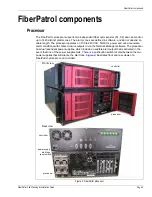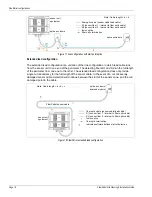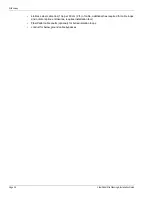
Site survey
Page 22
FiberPatrol Site Planning & Installation Guide
Gates
There are generally two types of gates used with fences, swinging gates and sliding gates. Sliding
gates must be bypassed, and should be protected by another type of sensor (e.g., a microphonic
non-fiber fence sensor, a microwave sensor, an IR beam). Swinging gates can be protected by
FiberPatrol sensor cable. Protected gates should consist of fence fabric attached to a rigid frame
that includes horizontal and vertical bracing. There are a number of factors that must be
considered when planning for gates, including whether it’s a single panel or double panel gate and
the type of ground beneath the gate (for cable bypass). Other gate requirements and concerns
include:
•
firmly attach all gate hardware accessories (minimum free-play)
•
make sure that double gates have travel stops (rigid anchors)
•
prevent locking hardware from moving in the wind
•
prevent sliding gate track hardware, supports, guides, etc., from rattling in the wind
•
the direction that the protected gate opens (to the inside of the perimeter OR both directions)
•
the frequency of gate use
•
gate use when the sensor is active (does the gate need to be accessed while the rest of the
fence is being protected)
Gate bypasses
To get the sensor cable from one side of a gate to the other, the sensor cable is buried below
ground inside conduit. The sensor cable continues the fence coverage beyond the gate. If site
conditions make it impossible to dig underground to continue the coverage on the other side of a
gate, install the cable above ground, over the gate, inside protective conduit.
Protecting swinging gates with FiberPatrol
To protect a swinging gate with FiberPatrol sensor cable, the sensor cable is passed through a
section of split conduit that is attached to the fence post that also supports the gate’s hinges. The
sensor cable passes around the outside of the gate panel, 30 cm in from the edge of the gate, then
passes through the split conduit a second time. The sensor cable is routed below ground through
conduit, to the other side of the fence, where the fence protection continues. All hardware on the
gate must be well secured to prevent any metal on metal contact while the gate is not in use.
Excess sensor cable at a gate location is coiled into a service loop on the hinged side of the gate.
Note
Bypassed gates should be protected with another sensor technology.
Figure 22 Gate bypass
microwave
sensor
seal conduit ends in areas
magnetic gate contacts
NOTE: Double arrows indicate a separation of 30 cm (1 ft.)
conduit
NOT TO SCALE
that include freezing temperatures
30 cm (1 ft.)
minimum
all turns must respect the minimum bend radius















































